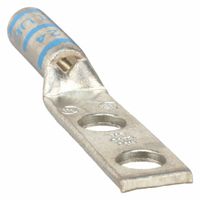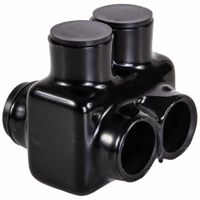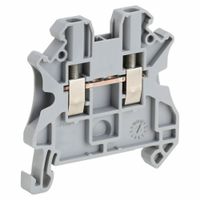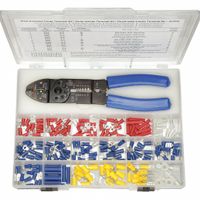Call +(254) 703 030 000 / 751 483 999 / 721 704 777
- Home
- Electrical
- Electrical Connectors Wiring Devices
- Wire Connectors Terminals Terminal Blocks
.....Read More
Frequently Asked Questions
What are the different types of wire connectors and their uses?
Wire connectors come in various types, each designed for specific applications:
1. **Twist-On Wire Connectors**: Also known as wire nuts, these are used to connect two or more wires by twisting them together. They are commonly used in residential and commercial electrical wiring for their ease of use and reliability.
2. **Push-In Wire Connectors**: These connectors allow wires to be pushed into a slot, securing them without the need for twisting. They are often used in lighting fixtures and junction boxes for quick and easy connections.
3. **Crimp-On Wire Connectors**: These require a crimping tool to secure the connection. They are used in automotive and industrial applications where a strong, vibration-resistant connection is needed.
4. **Screw-On Wire Connectors**: Similar to twist-on connectors but with a screw mechanism to secure the wires. They are used in applications where a more secure connection is required.
5. **Insulation Displacement Connectors (IDCs)**: These connectors cut through the insulation to make contact with the wire. They are used in telecommunications and networking for quick and reliable connections.
6. **Butt Connectors**: Used to connect two wires end-to-end. They are commonly used in automotive and marine applications for their ability to create a secure, inline connection.
7. **Spade and Ring Terminals**: These connectors are used to connect wires to terminal blocks or screw terminals. They are often used in automotive and industrial applications for their ease of installation and removal.
8. **Lever-Nut Connectors**: These connectors use a lever to secure the wire, allowing for easy connection and disconnection. They are used in applications where frequent changes to the wiring are needed.
9. **Waterproof Connectors**: Designed to protect connections from moisture, these are used in outdoor and marine applications to ensure a reliable connection in wet conditions.
How do you choose the right wire connector for a specific application?
To choose the right wire connector for a specific application, consider the following factors:
1. **Wire Type and Size**: Match the connector to the wire gauge and type (solid or stranded). Check the connector's specifications for compatibility.
2. **Current and Voltage Rating**: Ensure the connector can handle the electrical load. Check the maximum current and voltage ratings.
3. **Environmental Conditions**: Consider exposure to moisture, temperature extremes, and chemicals. Use connectors with appropriate IP ratings or materials like nylon for harsh environments.
4. **Connection Type**: Determine if you need a permanent or temporary connection. Use soldered or crimp connectors for permanent connections and quick-disconnects for temporary ones.
5. **Number of Connections**: Choose connectors that can accommodate the number of wires you need to connect, such as multi-port connectors for complex circuits.
6. **Installation and Maintenance**: Consider ease of installation and maintenance. Push-in connectors are user-friendly, while screw-type connectors offer secure connections.
7. **Mechanical Strength**: Ensure the connector can withstand physical stress and vibration. Use connectors with locking mechanisms for secure connections.
8. **Compliance and Standards**: Verify that the connector meets relevant industry standards and certifications, such as UL or CSA, for safety and reliability.
9. **Cost and Availability**: Balance cost with performance requirements. Ensure the chosen connector is readily available for future maintenance or expansion.
10. **Aesthetic and Space Constraints**: Consider the size and appearance of the connector, especially in visible or space-limited applications.
By evaluating these factors, you can select a wire connector that ensures safety, reliability, and efficiency for your specific application.
What is the difference between wire connectors and terminal blocks?
Wire connectors and terminal blocks are both used to join electrical wires, but they serve different purposes and have distinct characteristics.
Wire connectors, often referred to as wire nuts, are small devices used to connect two or more electrical wires together. They are typically made of plastic with a metal spring inside that grips the wires when twisted. Wire connectors are primarily used for splicing wires in residential and commercial electrical systems. They are easy to use, provide a secure connection, and offer insulation to prevent electrical shorts. Wire connectors are ideal for applications where wires need to be joined quickly and efficiently without the need for additional tools.
Terminal blocks, on the other hand, are modular, insulated blocks that secure and organize multiple wires. They consist of a series of terminals arranged in a long strip, allowing for the connection of multiple circuits. Terminal blocks are commonly used in industrial and commercial settings where complex wiring systems are present. They provide a more permanent and organized solution for connecting wires, often requiring a screwdriver to secure the wires in place. Terminal blocks offer the advantage of easy circuit identification and maintenance, as each wire can be individually connected and disconnected without disturbing other connections.
In summary, wire connectors are best suited for simple, quick wire splicing, while terminal blocks are used for more complex, organized, and permanent wiring solutions.
How do you properly install a wire connector or terminal block?
1. **Select the Right Connector**: Choose a wire connector or terminal block suitable for the wire gauge and application. Ensure it can handle the current load.
2. **Prepare the Wires**: Strip the insulation from the wire ends using a wire stripper, exposing enough conductor to fit into the connector or terminal block. Avoid nicking the wire strands.
3. **Twist Stranded Wires**: If using stranded wire, twist the strands together to prevent fraying and ensure a solid connection.
4. **Insert the Wire**: For wire connectors, insert the stripped wire end into the connector. For terminal blocks, insert the wire into the appropriate terminal.
5. **Secure the Connection**:
- **Wire Connectors**: Twist the connector onto the wire until it is tight and secure. Ensure no bare wire is exposed.
- **Terminal Blocks**: Tighten the screw or clamp to secure the wire. Use a screwdriver to ensure a firm connection without over-tightening, which can damage the wire.
6. **Check the Connection**: Gently tug on the wire to ensure it is securely connected. There should be no movement.
7. **Insulate if Necessary**: If using a terminal block in an area where insulation is required, cover the connection with electrical tape or a heat-shrink tube.
8. **Test the Connection**: Use a multimeter to check for continuity and ensure the connection is functioning correctly.
9. **Organize and Label**: Arrange wires neatly and label them if necessary for easy identification and maintenance.
10. **Safety Check**: Ensure all connections are secure and there are no exposed wires that could cause a short circuit or electrical hazard.
What are the safety considerations when using wire connectors and terminal blocks?
When using wire connectors and terminal blocks, several safety considerations are crucial to ensure proper functionality and prevent hazards:
1. **Correct Sizing**: Ensure connectors and terminal blocks are appropriately sized for the wires being used. Mismatched sizes can lead to poor connections, overheating, or electrical failure.
2. **Material Compatibility**: Use connectors and terminal blocks made from materials compatible with the wire type (e.g., copper or aluminum) to prevent corrosion and ensure a secure connection.
3. **Current Rating**: Verify that the connectors and terminal blocks can handle the current load of the circuit. Exceeding the rated capacity can cause overheating and potential fire hazards.
4. **Insulation Integrity**: Check that the insulation on connectors and terminal blocks is intact and suitable for the environment, providing protection against short circuits and electrical shock.
5. **Secure Connections**: Ensure all connections are tight and secure. Loose connections can lead to arcing, increased resistance, and potential fire risks.
6. **Environmental Conditions**: Consider the environment where the connectors and terminal blocks will be used. For harsh conditions, such as high moisture or temperature, use components rated for those environments to prevent degradation.
7. **Proper Installation Tools**: Use the correct tools for installation to avoid damaging the connectors or wires, which could compromise the connection and safety.
8. **Regular Inspection**: Periodically inspect connections for signs of wear, corrosion, or damage, and replace any compromised components promptly.
9. **Compliance with Standards**: Ensure all components meet relevant safety standards and regulations, such as those set by UL, IEC, or other local authorities.
10. **Training and Awareness**: Ensure that individuals installing or maintaining these components are properly trained and aware of safety protocols to prevent accidents and ensure reliable operation.
How do you troubleshoot issues with wire connectors and terminal blocks?
1. **Visual Inspection**: Check for visible damage, corrosion, or discoloration on connectors and terminal blocks. Ensure wires are properly stripped and inserted.
2. **Tightness Check**: Ensure all screws and clamps are securely tightened. Loose connections can cause intermittent faults or overheating.
3. **Continuity Test**: Use a multimeter to test for continuity across the connection. A lack of continuity indicates a break or poor connection.
4. **Voltage Measurement**: Measure voltage at the terminal block to ensure it matches expected levels. Discrepancies can indicate a faulty connection or component.
5. **Load Testing**: Apply a load to the circuit and monitor for voltage drops or overheating, which can indicate poor connections.
6. **Thermal Inspection**: Use an infrared thermometer or thermal camera to detect hotspots, which can indicate high resistance or poor connections.
7. **Re-termination**: If issues persist, cut and re-strip the wire, then reconnect to ensure a clean, solid connection.
8. **Corrosion Treatment**: Clean any corrosion with a suitable contact cleaner and apply a protective coating to prevent future issues.
9. **Connector Replacement**: If a connector or terminal block is damaged or worn, replace it with a new one to ensure reliable connections.
10. **Wire Gauge Check**: Ensure the wire gauge is appropriate for the current load. Undersized wires can overheat and cause connection issues.
11. **Environmental Factors**: Consider environmental factors such as moisture, vibration, or temperature that may affect connections and take steps to mitigate them.
12. **Documentation Review**: Check wiring diagrams and documentation to ensure correct wiring and connections.
13. **Professional Consultation**: If issues persist, consult with a professional electrician or engineer for further diagnosis and repair.
What are the best practices for maintaining wire connectors and terminal blocks?
1. **Regular Inspection**: Conduct routine checks for signs of wear, corrosion, or damage. Look for discoloration, rust, or loose connections.
2. **Proper Installation**: Ensure connectors and terminal blocks are installed according to manufacturer specifications. Use the correct tools and techniques to avoid over-tightening or under-tightening.
3. **Cleanliness**: Keep connectors and terminal blocks free from dust, dirt, and moisture. Use appropriate cleaning agents and tools to remove contaminants without damaging the components.
4. **Secure Connections**: Ensure all connections are tight and secure. Loose connections can lead to overheating and failure. Use torque tools to apply the correct amount of force.
5. **Use of Protective Coatings**: Apply anti-corrosion coatings or sealants to protect against environmental factors, especially in harsh conditions.
6. **Appropriate Materials**: Use connectors and terminal blocks made from materials suitable for the specific application environment, such as high-temperature or moisture-resistant materials.
7. **Labeling and Documentation**: Clearly label all connections and maintain accurate documentation for easy identification and troubleshooting.
8. **Avoid Overloading**: Ensure that connectors and terminal blocks are not overloaded beyond their rated capacity to prevent overheating and damage.
9. **Temperature Management**: Monitor and manage the temperature around connectors and terminal blocks to prevent thermal stress.
10. **Training and Awareness**: Ensure that personnel handling connectors and terminal blocks are adequately trained in best practices and safety procedures.
11. **Replacement of Damaged Parts**: Promptly replace any damaged or worn-out connectors and terminal blocks to maintain system integrity.
12. **Use of Proper Tools**: Utilize the correct tools for installation and maintenance to prevent damage to the connectors and terminal blocks.






